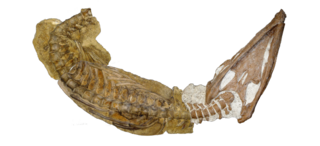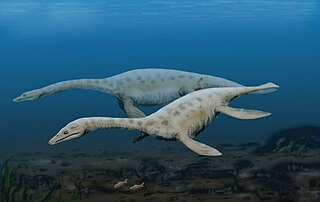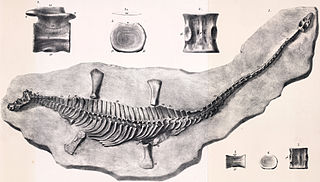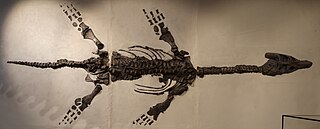
Pliosauroidea is an extinct clade of plesiosaurs, known from the earliest Jurassic to early Late Cretaceous. They are best known for the subclade Thalassophonea, which contained crocodile-like short-necked forms with large heads and massive toothed jaws, commonly known as pliosaurs. More primitive non-thalassophonean pliosauroids resembled plesiosaurs in possessing relatively long necks and smaller heads. They originally included only members of the family Pliosauridae, of the order Plesiosauria, but several other genera and families are now also included, the number and details of which vary according to the classification used.

Rhomaleosaurus is an extinct genus of Early Jurassic rhomaleosaurid pliosauroid known from Northamptonshire and from Yorkshire of the United Kingdom. It was first named by Harry Seeley in 1874 and the type species is Rhomaleosaurus cramptoni. It was one of the earliest large marine reptile predators which hunted in the seas of Mesozoic era, with the type species R. cramptoni measuring 6.7–7 metres (22–23 ft) long and weighing 2.1 metric tons. Like other pliosaurs, Rhomaleosaurus fed on ichthyosaurs, ammonites and other plesiosaurs.

Microcleidus is an extinct genus of sauropterygian reptile belonging to the Plesiosauroidea. The species has 40 neck vertebrae and a short tail of 28 vertebrae. Fossils of the genus have been found in France, the Posidonia Shale in Germany and Luxembourg, and the Alum Shale Formation of England.

Umoonasaurus is an extinct genus of plesiosaur belonging to the family Leptocleididae. This genus lived approximately 115 million years ago during the Early Cretaceous period, in shallow seas covering parts of what is now Australia. It was a relatively small animal around 2.5 metres (8.2 ft) long. An identifying trait of Umoonasaurus is three crest-ridges on its skull.

Pliosauridae is a family of plesiosaurian marine reptiles from the Latest Triassic to the early Late Cretaceous of Australia, Europe, North America and South America. The family is more inclusive than the archetypal short-necked large headed species that are placed in the subclade Thalassophonea, with basal forms resembling other plesiosaurs with long necks. They became extinct during the early Late Cretaceous and were subsequently replaced by the mosasaurs. It was formally named by Harry G. Seeley in 1874.

Polycotylidae is a family of plesiosaurs from the Cretaceous, a sister group to Leptocleididae. Polycotylids first appeared during the Albian stage of the Early Cretaceous, before becoming abundant and widespread during the early Late Cretaceous. Several species survived into the final stage of the Cretaceous, the Maastrichtian.

Thalassiodracon (tha-LAS-ee-o-DRAY-kon) is an extinct genus of plesiosauroid from the Pliosauridae that was alive during the Late Triassic-Early Jurassic (Rhaetian-Hettangian) and is known exclusively from the Lower Lias of England. The type and only species, is Thalassiodracon (Plesiosaurus) hawkinsi.

Brachauchenius is an extinct genus of pliosaurid that lived in North America and Morocco during the Late Cretaceous.

Leptocleidus is an extinct genus of plesiosaur, belonging to the family Leptocleididae. It was a small plesiosaur, measuring only up to 3 m (9.8 ft).

Simolestes is an extinct pliosaurid genus that lived in the Middle to Late Jurassic. The type specimen, BMNH R. 3319 is an almost complete but crushed skeleton diagnostic to Simolestes vorax, dating back to the Callovian of the Oxford Clay formation, England. The genus is also known from the Callovian and Bajocian of France (S.keileni), and the Tithonian of India (S.indicus). The referral of these two species to Simolestes is dubious, however.
Maresaurus is an extinct genus of plesiosaur from the Middle Jurassic (Bajocian) Los Molles Formation of Argentina. The type species, Maresaurus coccai, was named by Gasparini in 1997. Recent phylogenetic analysis found Maresaurus to be a rhomaleosaurid.

Leptocleididae is a family of small-sized plesiosaurs that lived during the Early Cretaceous period. They had small bodies with small heads and short necks. Leptocleidus and Umoonasaurus had round bodies and triangle-shaped heads. Leptocleidids have been found in what were shallow nearshore, freshwater and brackish habitats. Hilary F. Ketchum and Roger B. J. Benson (2010), transferred Brancasaurus, Kaiwhekea, Nichollssaura and Thililua to this family. However, Ketchum and Benson (2011) reassigned Kaiwhekea and Thililua to their original positions, as an elasmosaurid and a polycotylid, respectively.
Bobosaurus is an extinct genus of sauropterygian reptile related to plesiosaurs. It is based on the holotype MFSN 27285, a partial skeleton found in Early Carnian-age rocks of the Rio del Lago Formation, northeastern Italy. Bobosaurus was named in 2006 by Fabio M. Dalla Vecchia and the type species is B. forojuliensis. It may be a pistosaurid, or closer to Plesiosauria. A recent cladistic analysis found it to be a pistosaur. It was relatively large animal, with more than 3 m (9.8 ft) in length.

Rhomaleosauridae is a family of plesiosaurs from the Earliest Jurassic to the latest Middle Jurassic of Europe, North America, South America and possibly Asia. Most rhomaleosaurids are known from England, many specifically from lower Blue Lias deposits that date back to the earliest Jurassic, just at the boundary with the Triassic. In fact, to date only two undisputed rhomaleosaurids were named from outside Europe - the closely related Borealonectes russelli and Maresaurus coccai from Canada and Argentina, respectively. These two species are also the only Middle Jurassic representatives of the family. Rhomaleosauridae was formally named by Kuhn in 1961, originally proposed to include Rhomaleosaurus cramptoni and its relatives, which have short necks and large heads relatively to plesiosauroids like Elasmosaurus and Plesiosaurus, but longer necks and smaller heads relatively to advanced pliosaurids like Pliosaurus and Kronosaurus.

Meyerasaurus is an extinct genus of rhomaleosaurid known from Holzmaden, Baden-Württemberg of southwestern Germany.

Pistosauroidea is a group of marine reptiles within the superorder Sauropterygia that first appeared in the latter part of the Early Triassic and were the ancestors of plesiosaurs. Pistosauroids are rare in Triassic marine assemblages, and are represented by only a few fossils from central Europe, the United States, and China. Recent phylogenetic analyses consider the Triassic pistosauroids to be a paraphyletic grouping, meaning that they do not form a true clade. Plesiosauria is now placed within Pistosauroidea, while the traditional pistosauroids are successively more basal, or primitive, sauropterygians.

Avalonnectes is an extinct genus of small-bodied rhomaleosaurid known from the Early Jurassic period of the United Kingdom. It contains a single species, A. arturi.

Microcleididae is an extinct family of basal plesiosauroid plesiosaurs from the Early Jurassic of France, Germany, Portugal and the United Kingdom. Currently, the oldest and the most known microcleidid is Eretmosaurus from the middle Sinemurian of the United Kingdom. Microcleididae was formally named and described by Roger B. J. Benson, Mark Evans and Patrick S. Druckenmiller in 2012.

Atychodracon is an extinct genus of rhomaleosaurid plesiosaurian known from the Late Triassic - Early Jurassic boundary of England. It contains a single species, Atychodracon megacephalus, named in 1846 originally as a species of Plesiosaurus. The holotype of "P." megacephalus was destroyed during a World War II air raid in 1940 and was later replaced with a neotype. The species had a very unstable taxonomic history, being referred to four different genera by various authors until a new genus name was created for it in 2015. Apart from the destroyed holotype and its three partial casts, a neotype and two additional individuals are currently referred to Atychodracon megacephalus, making it a relatively well represented rhomaleosaurid.





















